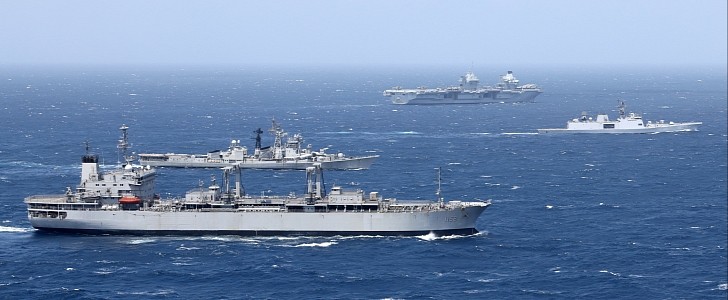As part of the UK's forthcoming Carrier Strike Group tour, Rolls-Royce will showcase its capabilities in advanced technologies, including the MT30 power-dense marine gas turbine for naval vessels, to Indian Navy customers. The company also announced plans to support the electrification of India's next-generation warships.
On October 15th, the UK's Carrier Strike Group, led by HMS Queen Elizabeth has sailed into the Bay of Bengal, completing its second voyage in the past three months aimed at demonstrating the expansion of the two countries' strategic partnership. During the 40-nation tour, Rolls-Royce plans to showcase naval propulsion solutions aboard the HMS Queen Elizabeth warship, which includes the MT30 marine gas turbine and a low voltage electrical distribution system.
"The HMS Queen Elizabeth visiting India is one of the finest examples of technological excellence in naval warfare. We are looking forward to familiarising our Indian customers with Rolls-Royce's capabilities aboard this majestic warship and to explore areas for collaboration to further strengthen the might and range of the Indian Navy," said Abhishek Singh, Senior Vice President – Defence, India and South East Asia, Rolls-Royce.
The Royal Navy's new Queen Elizabeth aircraft carriers have an Integrated Full Electric Propulsion (IFEP) system, which is capable of providing more power, flexibility, and reliability. It includes two MT30 marine gas turbine alternators that generate 36 MW. That's enough power to propel the vessels beyond 25 knots (29 mph/ 46 kph).
The MT30 provides substantial design benefits through its power density, drastically reducing the number of gas turbines necessary to power modern naval vessels. The HMS Queen Elizabeth also has a robust Rolls-Royce low voltage electrical distribution system that can power the equivalent of 5,000 homes.
Rolls-Royce hopes to provide the best options for integrating hybrid-electric and fully electric propulsion systems for Indian Navy's vessels, including the integration of the MT30, which is introducing one of the most powerful gas turbines to the next-generation warships.
"The HMS Queen Elizabeth visiting India is one of the finest examples of technological excellence in naval warfare. We are looking forward to familiarising our Indian customers with Rolls-Royce's capabilities aboard this majestic warship and to explore areas for collaboration to further strengthen the might and range of the Indian Navy," said Abhishek Singh, Senior Vice President – Defence, India and South East Asia, Rolls-Royce.
The Royal Navy's new Queen Elizabeth aircraft carriers have an Integrated Full Electric Propulsion (IFEP) system, which is capable of providing more power, flexibility, and reliability. It includes two MT30 marine gas turbine alternators that generate 36 MW. That's enough power to propel the vessels beyond 25 knots (29 mph/ 46 kph).
The MT30 provides substantial design benefits through its power density, drastically reducing the number of gas turbines necessary to power modern naval vessels. The HMS Queen Elizabeth also has a robust Rolls-Royce low voltage electrical distribution system that can power the equivalent of 5,000 homes.
Rolls-Royce hopes to provide the best options for integrating hybrid-electric and fully electric propulsion systems for Indian Navy's vessels, including the integration of the MT30, which is introducing one of the most powerful gas turbines to the next-generation warships.






